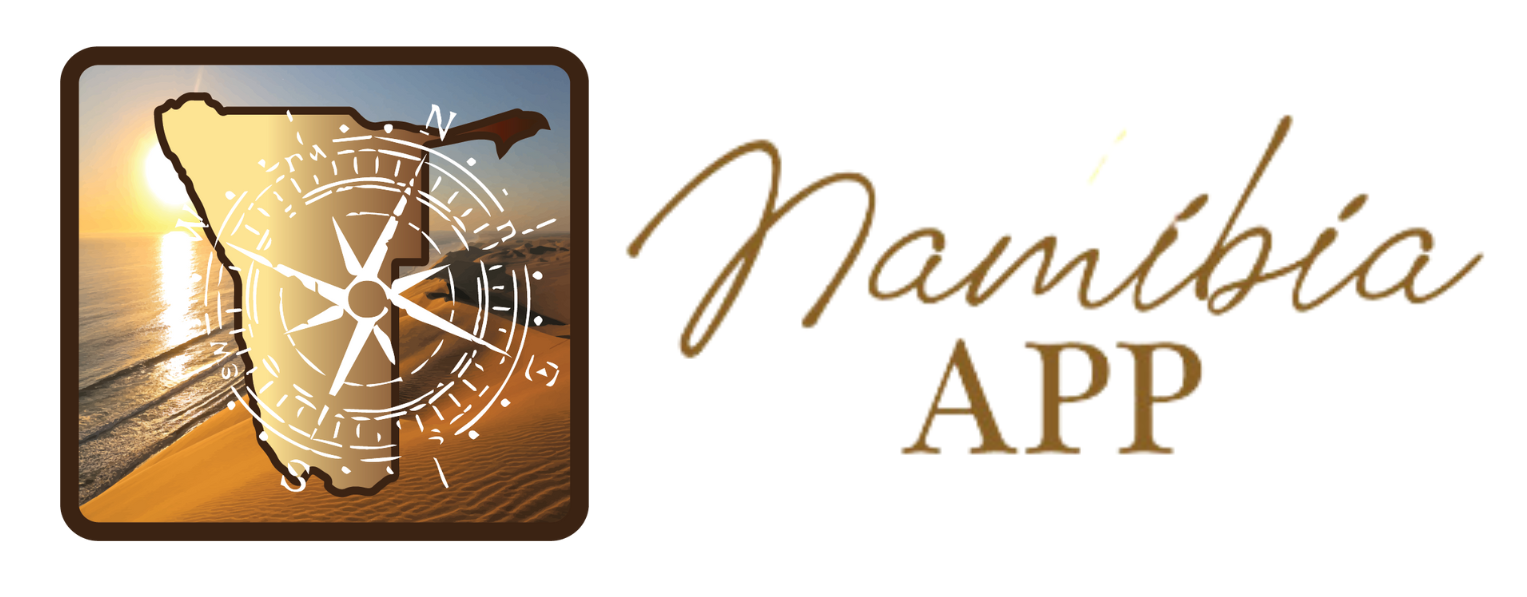Exploring Namibia's Western Region

The Western Region is centred around the Namib Coastline, which offers a welcome respite from the heat of the interior. The quaint little town of Swakopmund is Namibia’s premier holiday resort with its wealth of well-preserved German colonial buildings, its palm-lined streets, and clean beaches.
Activities abound in and around Swakopmund. From dune boarding to sky-diving and ballooning over the desert, township tours, and tours into the desert, there is much to do and see in this area. Walvis Bay is Namibia’s major port and the center of Namibia’s fishing industry. Most boating activities are launched from Walvis Bay’s waterfront which has become a big tourist attraction. The calm waters of the lagoon attract many watersport enthusiasts like windsurfers, kiteboarders, and sailors.
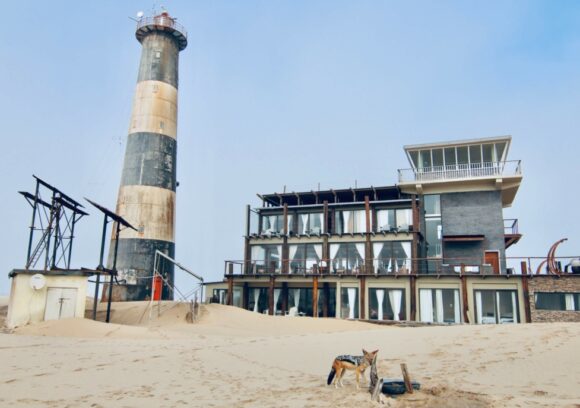
Pelican Point is also known for its rough beauty, and the newly built eco-lodge at the tip of the peninsula offers comfort and a rather different view of the lagoon and Walvis Bay as a whole. Donkey Bay is a well-known surfing spot for international surfers from all over the world who come here to share the icy waters with the hundreds of seals around the lighthouse. Many 4×4 excursions to Sandwich Harbour start out in Walvis Bay. Sandwich Harbour lies about 40 km south of Walvis Bay with dunes sweeping down to a pristine lagoon with views and scenery to die for — a photographer’s dream.
But if it is just fishing that tickles your fancy, the coastline to the north of Swakopmund and Henties Bay offers exciting spots with amusing names such as “Sarah se Gat” and “Bennie se Rooi Lorry”, or Jakkalsputz. From Mile 4 and Wlotzka’s Baken right up to Henties Bay, Torra and Terrace Bay, you’ll find many fishing spots, directly accessible by 4×4 which makes fishing a family affair with camps being built on the beach and family and friends gathering for a fun-filled day on the beach.

Further inland, the Brandberg offers the highest peak in Namibia: Koenigstein (2570 m above sea level). In addition, it offers 44,000 rock paintings, the most popular of which is the White Lady in the Tsisab Ravine. The Erongo mountains to the south-west of Omaruru also contain a wealth of rock paintings and the town of Omaruru itself has become somewhat of an art centre, featuring many coffee shops, art and decor, as well as its own chocolate/praline factory.
The Spitzkoppe is considered the “Matterhorn of Namibia” and with its granite rock walls of up to 600m, it is Namibia’s top rock climbing destination.
Many lodges and guestfarms in and around these tourist attractions have exciting game viewing possibilities of all types of game including the big 5.
Places of Interest in the Western Region:
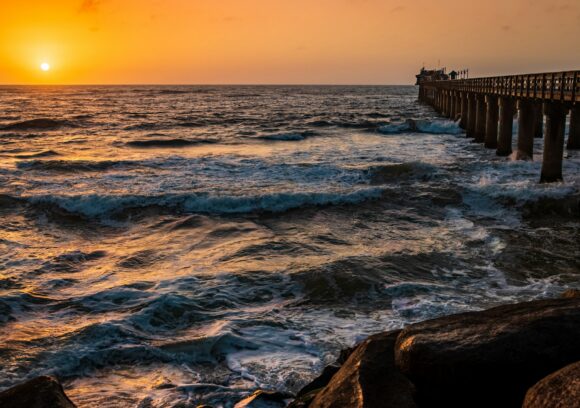
Swakopmund
When you approach Swakopmund on the tar-red road from the interior, its quaint assemblage of towers and turrets rise mysteriously from the mist, creating a mirage of an ancient city in a faraway land. These atmospheric conditions are generated by the dense bank of coastal fog that hangs over the cold Atlantic Ocean on most mornings, dissipating as the sun rises higher in the sky. Sometimes the sea is a sleek silver mirror; other times it is grey and stormy, with waves breaking onto the shore in rollers of thick white froth.
Germany’s annexation of the territory of Deutsch-Sudwestafrika became reality in August 1884 when the German flag and wooden notice boards were planted at various points along the south-west African coast, proclaiming the protection of the Reich, and supplanting, after 400 years, Portugal’s claims to sovereignty over the territory.

There was only one viable natural harbour along the coast, namely Walvis Bay, but it was still in British hands. The new German colony’s need for a port of its own led to the founding of Swakopmund in 1892, and it served as the territory’s main harbour for many years.
Today the coastal town is Namibia’s main seaside resort, and locals descend on it from the interior in large numbers to escape the heat of the summer (December/ January).
The town has a cool and bracing climate, and its large number of restaurants carefully tended public gardens, a wide choice of pensions and hotels, and coffee shops selling traditional German cakes and pastries make it an enjoyable holiday destination.
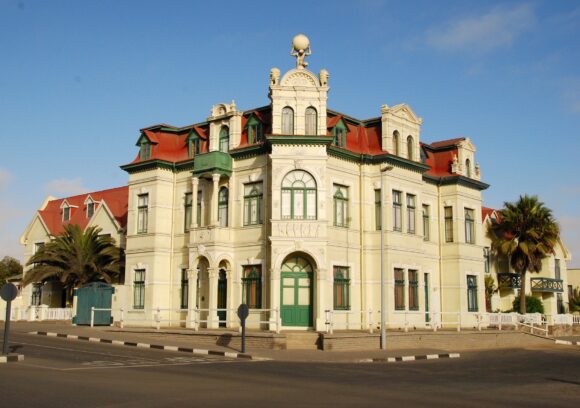
Many of the old colonial buildings with their distinct German architecture have been preserved, such as Woermann House, built in 1905, which houses the Swakopmund Arts Association and the Public Library; Die Alte Kaserne (1905), today a youth hostel based on the concept of the International Youth Hostel Federation; the privately owned Hohenzollern-Haus (1905); and the Prinzessin Rupprecht Heim, built-in 1902 as a hospital, today serving as a pension.
The Old Iron Jetty, originally built in 1911, is a well-known landmark that was closed for repairs for many years and was re-opened to the public in 2006. The Swakopmund Museum is a small but comprehensive institution with displays ranging from natural history, botany, and mineralogy to ethnological and historical displays.
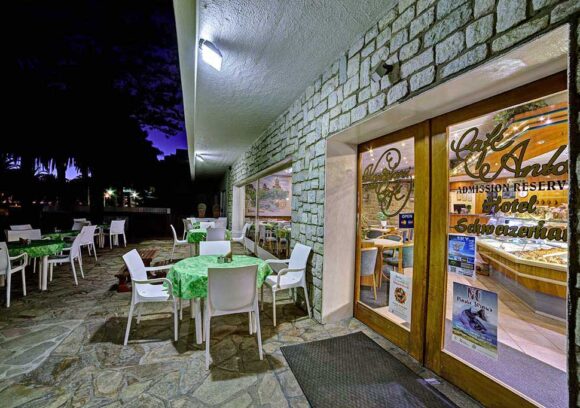
On the beachfront is the Swakopmund Aquarium, a favourite among children with its transparent oval-shaped tank and glass walk-through tunnel. An interesting shop to visit is the KristalI Galerie with its specialist mineral displays, including gigantic quartz crystal clusters.
A visit to Swakopmund would not be complete without enjoying coffee and cake at Cafe Anton, famous for delectable classics such as Schwarz-Walder Kirschtorte, Florentiner, and Apfelstrudel.
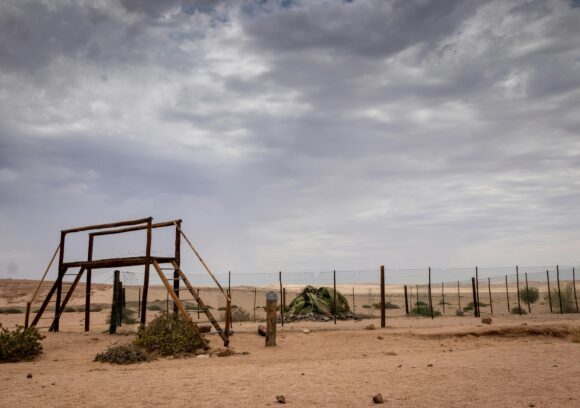
Welwitschia Plains
Inland from Swakopmund, like huge bundles of tangled wool, the ancient Welwitschias of the central Namib sprawl randomly across the well-known Welwitschia Plains in the Namib-Naukluft Park. This intriguing stand of plants can be viewed when traveling through the proclaimed road in the northern section of the park.
The Welwitschia mirabilis is a botanical curiosity endemic to the Namib Desert. The plants grow in a narrow belt that lies between 30 to 40 kilometers inland, from the Kuiseb River in central Namib more or less up to Mossamedes in Angola.
The best specimens grow amongst the hills of the Messum Crater southwest of the Brandberg. Here, sheltered from the winds, they grow relatively luxuriantly, with less of the desiccated and wind-shredded look of the Welwitschias of the plains.
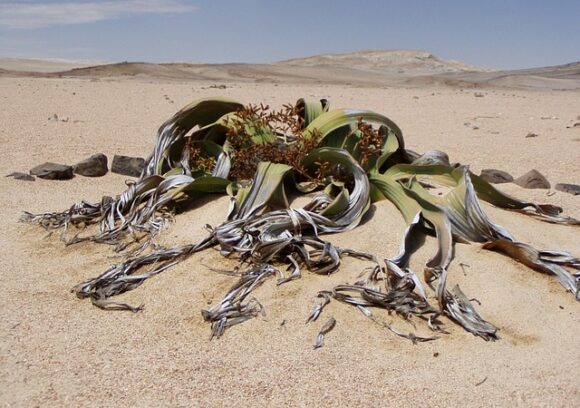
The Welwitschia is a tree that has been dwarfed by the rigors of the desert, the major portion of its stem having been driven underground. The fibrous taproot is quite shallow, with many lateral roots just below the surface. The crown of the stem is flattened and shaped like a saucer, dark brown, hard, and woody. The plant produces only two leaves throughout its lifetime.
They grow opposite each other from the base outwards and are up to three meters long. The tough and leathery leaf blades, torn into long, thong-like shreds by the searing winds, are constantly blackened and worn away by the scorching desert sun. The Welwitschia is dioecious, that is the male and female flowers are on separate plants.
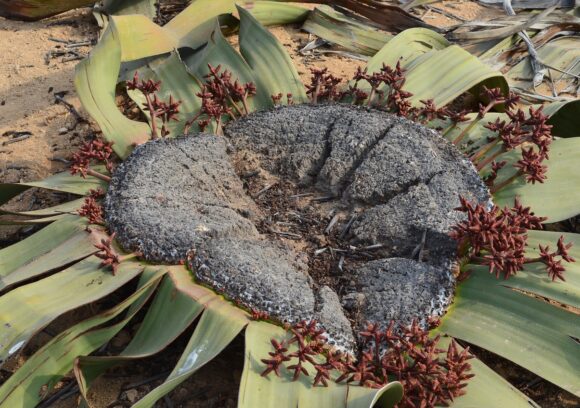
The flowers are often brightly coloured, the male cones salmon pink and the female ones much larger and of a greenish-yellow colour, banded with reddish-brown, sometimes dark pink. A conspicuous red beetle with the impressive scientific name of Probergrothius sexpunctatis inhabits these plants. This insect is associated only with Welwitschias and is therefore also endemic to the Namib.
Welwitschias are not only of ancient origin but are also extremely long-lived. The age of one of the larger specimens has been estimated at 2,000 years, while carbon-14 dating indicates that average specimens such as those seen on the Welwitschia Plains are between 500 and 600 years old.
A magnificent specimen, known as the Great Welwitschia and estimated to be 1,500 years old, can be seen along the Welwitschia Trail, which runs across the plain.
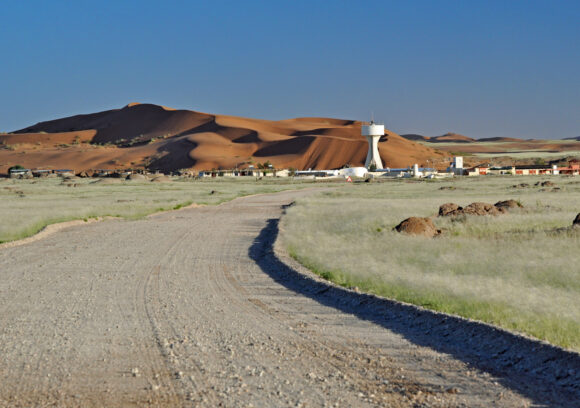
Gobabeb
For the last fifty years scientists, researchers, students, filmmakers, artists, and tourists have converged on Gobabeb, a world-renowned research institution in the central Namib Desert approximately 85 kilometers south-east of Walvis Bay.
The complex is located on the northern bank of the ephemeral Kuiseb River that runs through the Namib-Naukluft Park to Walvis Bay. Over the years a great deal of detailed research on the geology, ecology, landscape, and history of the Namib Desert has been carried out at this institution.
Gobabeb was founded in 1962 as the Namib Desert Research Station by the world’s foremost desert beetle taxonomist at the time, Dr Charles Koch. The well-known Dr Mary Seely, who started as a researcher at the station in 1967, became director in 1970, leading and expanding the program for the next 28 years, consolidating its international reputation and pursuit of scientific excellence.
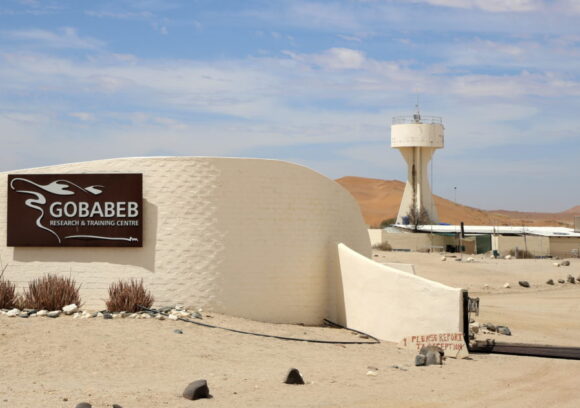
Today, under the directorship of Dr Joh Henschel, the Gobabeb Training and Research Centre continues to host scientists, students, filmmakers, artists, and casual visitors interested in finding out more about the Namib Desert.
The training program at the Research Centre is aimed at enhancing understanding of sustainable development at all levels. School groups visit to learn more about climate change, biodiversity, and the Namibian environment, and students from the University of Namibia and the Polytechnic spend anything from a week to a month applying their theoretical training.
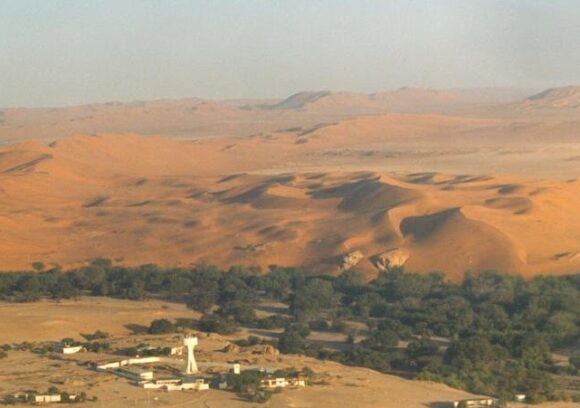
Tertiary students from other parts of the world come to Gobabeb to pursue MSc and Ph.D. research, often in collaboration with Namibian students. The research program provides a broad framework for individual researchers to take on challenges such as ephemeral river functioning and management practices in arid lands.
The Gobabeb Open Day is an annual event that provides an opportunity for members of the public to make a trip to the research station and learn more about its activities. Each year has a different theme and Gobabeb staff members give presentations of their various research activities, covering the current programs and training projects.
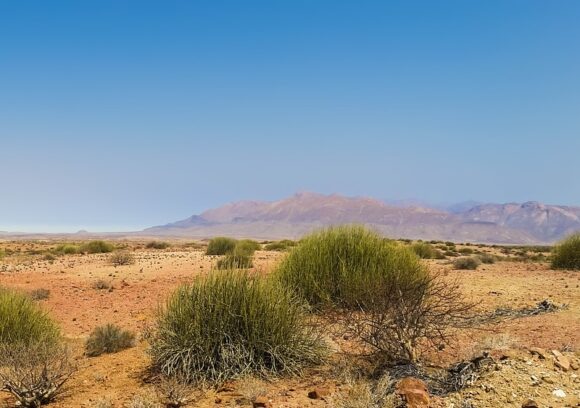
Brandberg – Mountain of Mystery
Owing its name to its glowing red appearance at sunset, the Brandberg massif lies south of the Ugab River about 40 kilometres northwest of Uis.
Around 120 million years ago the area was a volcano set in a vast plateau of volcanic rock. Subsequent erosion of the surrounding lavas gradually exposed the massive chunk of weather-resistant granite, providing the numerous overhangs used as shelters by Bushmen.
The Brandberg is the site of Konigstein, at 2 574 metres the highest peak in Namibia. It is also the site of an internationally renowned heritage of rock paintings, including the famous White Lady, which can be seen on an overhang in Maack’s Shelter, Maack being the surveyor who discovered it, and other paintings in the Tsi-sab Valley in 1917.

However, it was only in 7955 that the White Lady became known to international rock art specialists when it was copied and described by the French archaeologist and cleric, Abbe Henri Breuil.
Since then there has been a great deal of controversy over its meaning and origin, the latest being that the figure is neither white nor a female, but rather a male medicine man wearing body paint. There are at least 17 other sites of rock paintings depicting lions, giraffes, and ostriches within a one-mile radius of Maack’s shelter.
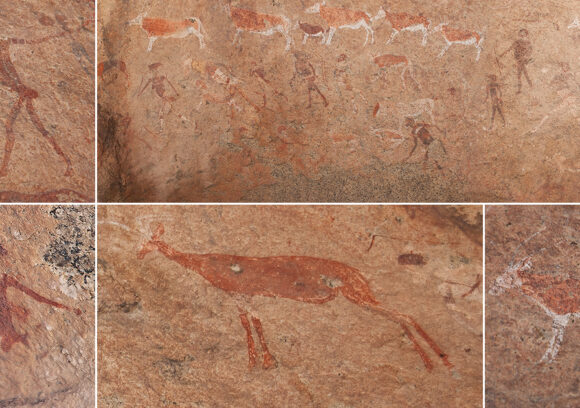
The White Lady is surrounded by paintings of animals, and although the frieze has faded over the years and has an iron grid in front of it to protect it from vandals, it is well worth the effort to go and see it. The walk up the Tsisab Gorge to reach Maack’s Shelter, which takes about an hour along a well-marked route, should not be undertaken at midday, due to high temperatures.
The Brandberg paintings are estimated to be between 2,000 and 4,000 years old. About 8,000 were photographed and documented by the late Harald Pager, a task which took him many years, and the results were published in several volumes. A good way to view the paintings of the Brandberg is on the guided tours presented by the local Daureb Mountain Guides.
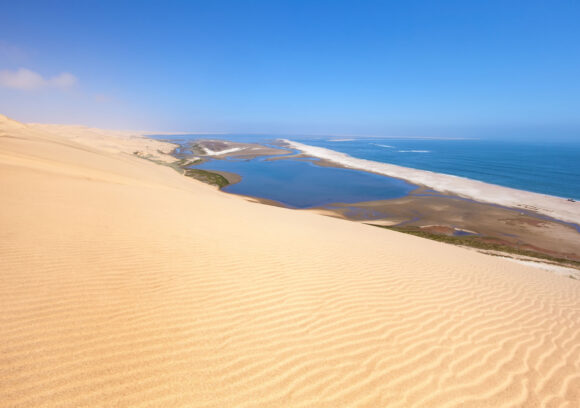
Sandwich Harbour
One of Namibia’s most magical places is undoubtedly Sandwich Harbour, a saltwater lagoon surrounded by extensive mud flats and reed-lined pools fed by freshwater springs.
Sandwich is one of Southern Africa’s most important wetland areas, providing refuge to thousands of birds, including pelicans and flamingos, at any one given time, and giving shelter to countless thousands of migrants every year. It is also an important breeding ground for several fish species.
Situated some 48 kilometers south of Walvis Bay at the foot of massive ivory-colored dunes, Sandwich Harbour is much sought after by photographers and artists for its singular beauty and grandeur. Its inaccessibility — it can be reached only by a four-wheel-drive vehicle — enhances its allure and mystique.
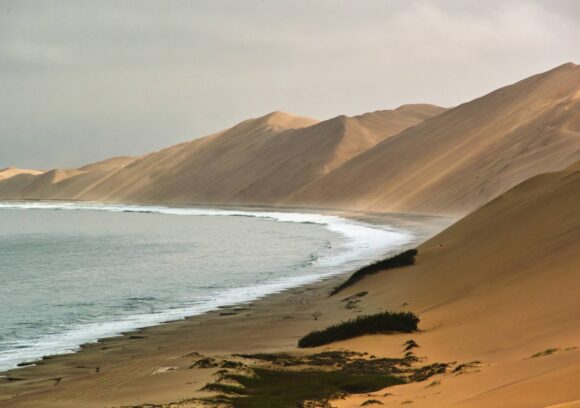
This is augmented by the legend that buried in the sands above the high-water mark are the remains of a ship that carried in its hold a rich cargo of gold, precious stones, and ivory.
Over the years these treasures have been sought by fortune hunters and adventurers, but no traces of the ship or its cargo have ever been found. Referred to in old texts as Sandfisch Haven, the lagoon was once an open bay at its northern end, which became silted up over the years.
The changing shoreline of the bay is indicated on some of the older maps with dots rather than solid lines. In the past Sandwich served several purposes, for instance as a shelter for whalers during storms. In the mid-1900s a trading station was established here for curing fish and producing shark liver oil and sealskins, which were transported down the coast to Cape Town and Mauritius.
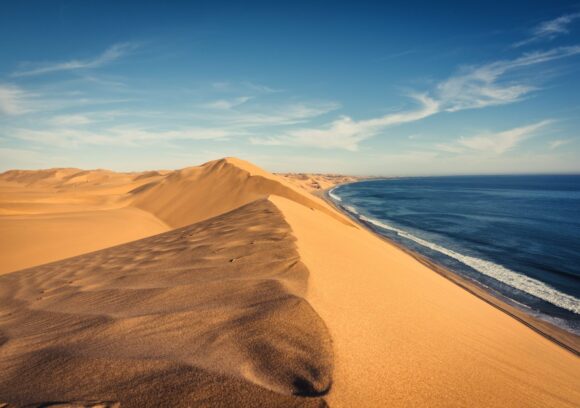
Today it’s visited primarily by tourists, anglers, and bird watchers. About 115 species have been recorded here, including 18 Palaearctic waders, 20 seabirds, 34 water birds, and 18 land birds. Because it lies in the Namib-Naukluft Park, permits are required from the Ministry of Environment and Tourism.
These can be obtained at several service stations and through tour operators in Swakopmund and Walvis Bay.
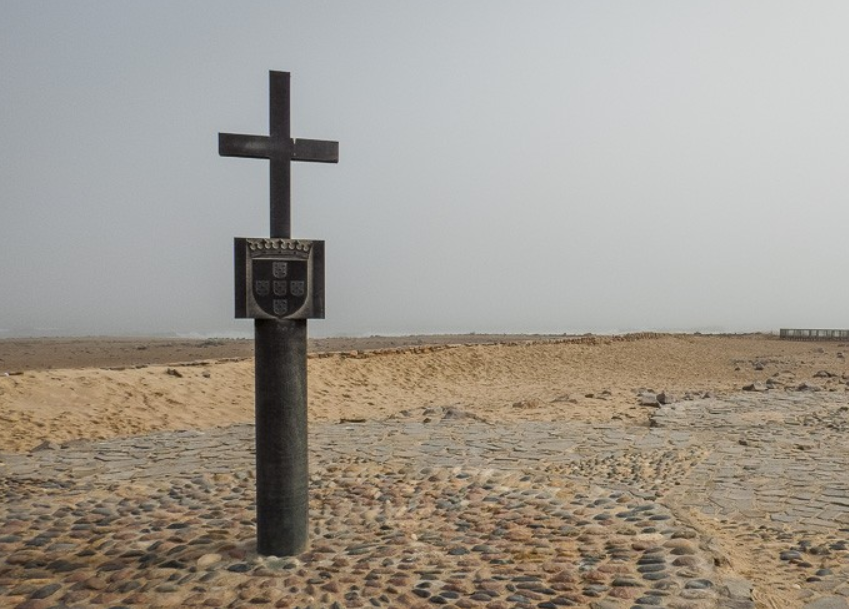
Cape Cross
In 1486, before there were clear maps of the Southern African coast, the Portuguese navigator, Diego Cao, on one of his journeys in search of a sea route to the Far East, landed at Cape Cross, about 130 kilometers north of Swakopmund.
Here he planted a stone cross or padrao, to mark being the first European of his time to reach this far down the west coast of Africa. His cross remained in place until the 1890s when it was removed and taken to the Oceanographical Museum in Berlin. In 1974 the whole area was landscaped and a replica cross was erected.

Today Cape Cross is visited primarily for its seal reserve, which is one of the easiest to reach along the Namibian coast. With its surrounding area of 60 square kilometers, the seal reserve was proclaimed in 1968 to protect the largest of the 23 colonies of Cape fur seals, Arctocephaius pusillus, which breed along the coast of South Africa and Namibia.
At any one time the colony numbers from 200 000 to as many as 340 000 animals. The large hull seals arrive in mid-to-late October, staking their territorial claims and defending them from other males.

In late November or early December, the females give birth to their pups, which remain in and around the colony, continuing to suckle for the next ten to eleven months. At any time of the year, visitors are greeted with the spectacle of tens of thousands of heads bobbing on land and in the water.
Also of interest in the vicinity is the Cape Cross lichen reserve, where visitors are requested to stay on the existing roads and to inspect these interesting organisms on foot. If a little water is sprinkled on them, they come to life magically, displaying interesting colours and becoming soft and leathery to the touch.
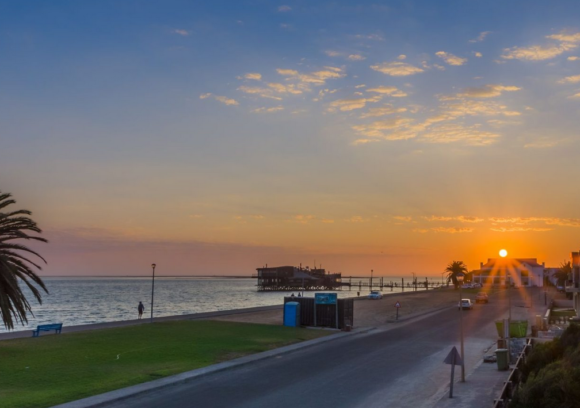
Walvis Bay
The Walvis Bay Lagoon is regarded as the most important wetland for coastal birds along the west coast of Southern Africa, not only for the numerous resident species it harbours, but especially for the vast numbers of intra-African and Palaearctic migrants that frequent its tranquil waters. Because of its value nationally and internationally as a wetland area, it was declared a RAMSAR site, RAMSAR being the convention on wetlands held in 1971 in Ramsar, Iran, and is listed as a Natural Heritage Site.
The lagoon area is especially known for the large numbers of lesser arid greater flamingos it attracts to its rich feeding grounds. Black-necked grebes are seen in rafts of up to 800 individuals.
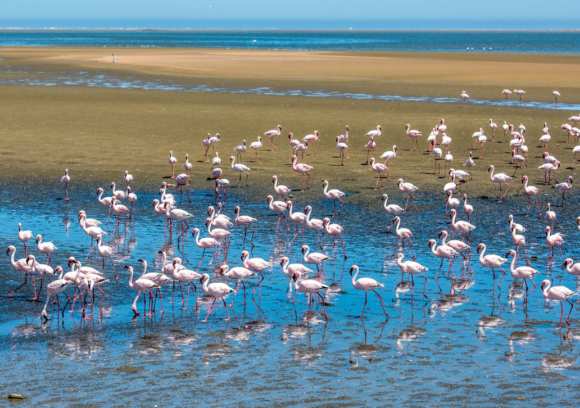
Populations of migratory waders supported by the lagoon include curlew sandpipers, red knots, bar-tailed godwits, white-fronted plovers arid tens of thousands of Caspian and swift terns. A good time to visit the lagoon is between October and April when Damara terns and chestnut-banded plovers breed.
Habitats additional to the tidal lagoon are the sewage works wetland, salt works with extensive evaporation pans, open ocean, and shoreline, and the Kuiseb River bed and dune area. The Bird Sanctuary is a series of ponds with emergent reed beds formed by the runoff from the sewage works.

The Rooibank area with the Kuiseb riverbed, narra-vegetated hummock dunes, and larger dune area is home to the only true Namibian endemic, the dune lark, which can be seen at the base of the main dunes on the southern bank, between the hummocks and tussocks.
A late afternoon visit to the guano platform about nine kilometers from Walvis Bay can be rewarding, as large numbers of Cape cormorants return here to roost. Other birds seen here are black terns, Eurasian and African black oystercatchers, and white-breasted and crowned cormorants. This is thought to be the only place in Namibia where the great white pelican breeds.
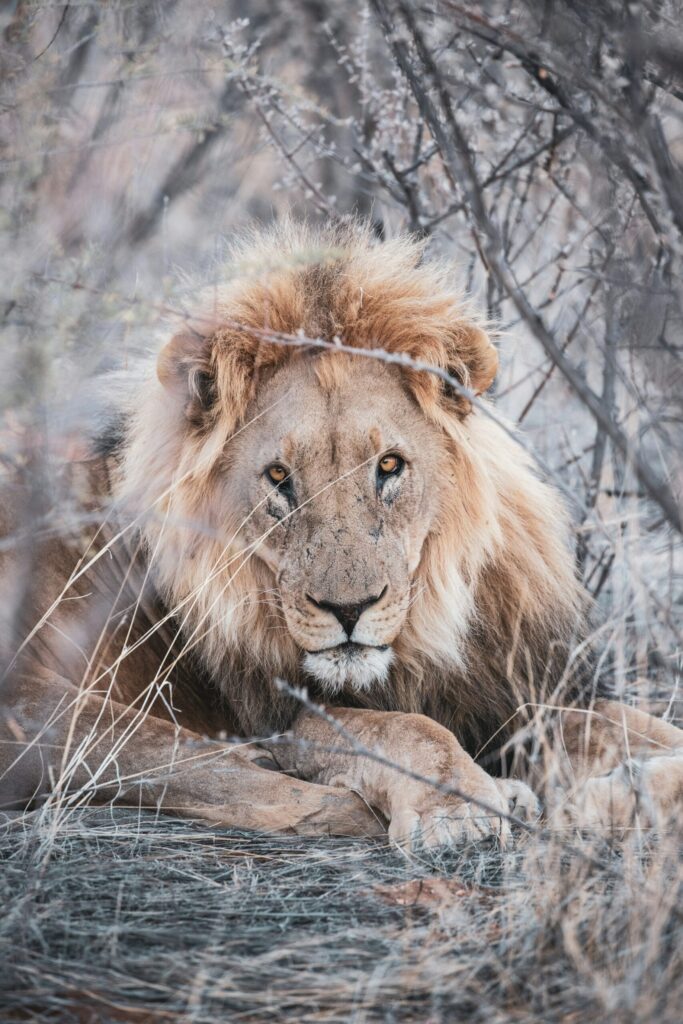
Omaruru
Beautiful Omaruru has a definite artistic feel to it. It is surrounded by a green belt due to the ephemeral Omaruru River running: through the town, making it look like a little oasis in the heart of the Erongo Region.
Even though it only flows after particularly good rains, the riverbed has natural alluvial aquifers that store and also: supply Henties Bay and Swakopmund with water. The river itself originates from a small perennial well in the Otjozondjupa escarpment at an altitude of 1200 m: near Kalkfeld.
The Omaruru river-basin covers 2,4% of Namibia’s land area and includes two major mountain ranges, the Erongo and Spitzkoppe. The river supports a population of more than 55,000 people with a mere rainfall of 50 — 350 mm per annum.
Omaruru is conveniently located en route to the North of Namibia, on the C33, only 50 km from Karibib and 230 km from Windhoek. The name “Omaruru” is derived: from the Otjiherero “amaere omarum”, which means “bitter curd” and describes how cow’s milk tasted after eating a particular bush that only grows in the area around the town.
The missionary Hugo Hahn was the first European to reach the area in 1851. In 1868 • the Herero Chief Zeraua settled in Omaruru, but officially the town was only founded in 1870 when another missionary, Gottlieb Viehe arrived.
Swedish big game hunters then arrived and built the first permanent houses in the town. Unfortunately, they also eliminated all big herds of elephants, black rhinos, plains game, and lions that roamed the Omaruru River at that time.
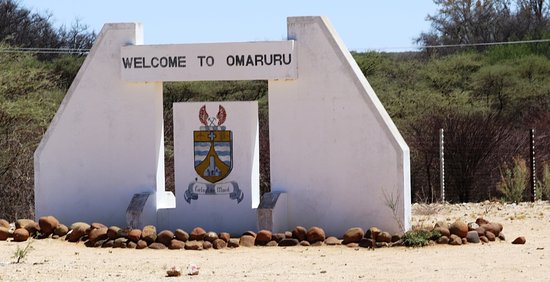
In 1880 Herero-Nama wars brought Omaruru under attack but finally in 1889 peace was restored. In 1894 the German garrison was stationed at Omaruru and the town subsequently grew to house the biggest number of European settlers in Namibia.
During the Herero uprising in 1904, the town was besieged. Captain Franke, the military commander at the time, who was away in the south on a mission, marched 900km in 20 days to break the siege by leading a cavalry charge and defeating the Hereros. Franke’s Tower was built in 1907 to commemorate the event and in 1909 Omaruru received full municipal status.
Nowadays Omaruru is a peaceful artistic town with about 14,000 inhabitants, many art galleries, coffee shops, and all the amenities you require.
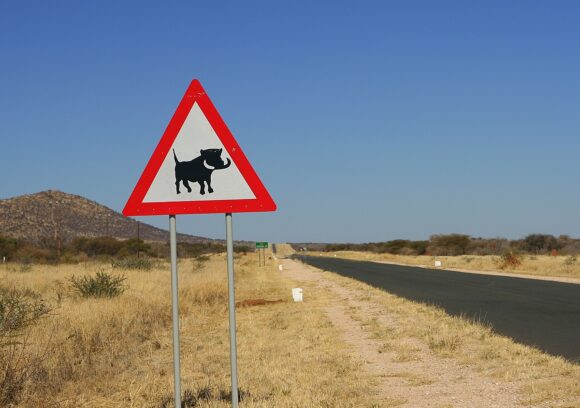
Due to private conservation efforts, much of the wildlife has returned to this area with many game farms/lodges in its vicinity.
The picturesque setting of Omaruru, amidst an array of mountains with the most prominent, the Oruwe Mountain, located southeast of the town, makes its appeal all the more intriguing.
Make Omaruru a destination, rather than a mere stopover between the Etosha Pan and the coast. There is lots to do and experience in this little gem of a town: – Visit the San community in the Erongo mountains – Browse through the various arts and crafts shops along the Main Road – Visit Omaruru’s own winery and chocolate factory – Have your aquamarine or tourmaline cut before your eyes Have German-style Kaffee & Kuchen (coffee and cake)
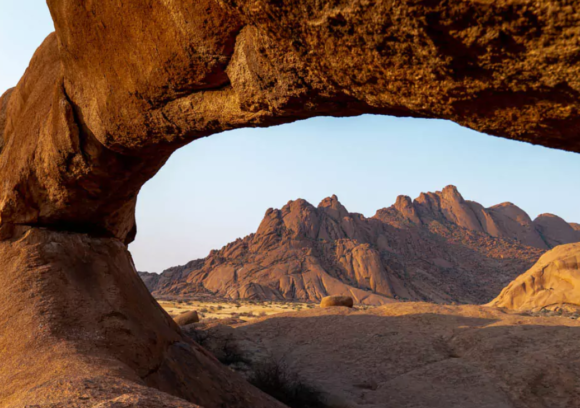
The Spitzkoppe
The rock mountain of Spitzkoppe, also known by the name of “Matterhorn of Namibia”, is nearly 700 million years old. It can be seen and accessed from the B2 national road between Usakos and Swakopmund.
This well-known landmark consists of a group of smooth granite peaks, the highest outcrop rising about 1784 meters above sea level. The peaks stand out dramatically from the flat surrounding plains with the highest peak rising about 700m above the ground floor level.
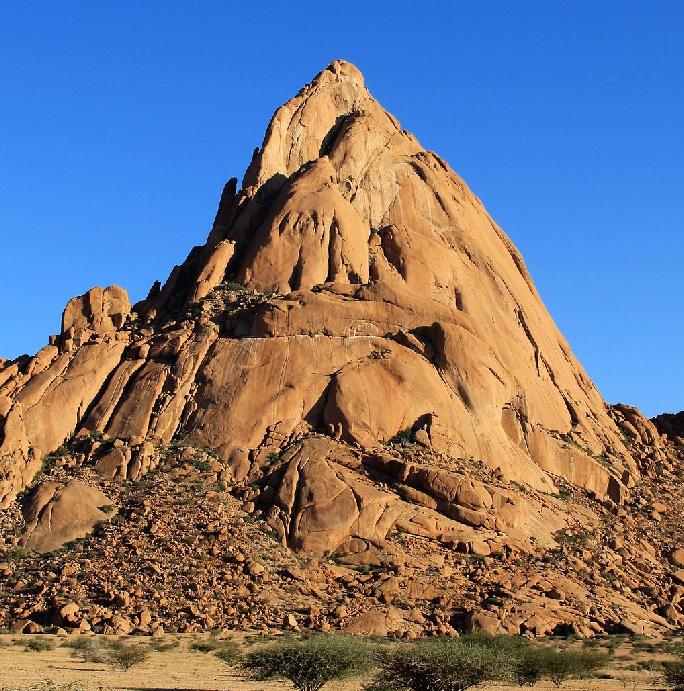
Another minor rock formation, the “Little Spitzkoppe” has an elevation of 1584 meters above sea level. Other prominences stretch out into a range known as the “Pontok Mountains”.
If camping, hiking, rock climbing, and stargazing are your thing, then you simply have to visit this magical site. A day trip almost does not do it justice. Rather stay a night and camp under the stars — they shine so bright (especially in the clear, crisp winter months) that you almost want to stay up all night long.
Even some thatched rooms are available — if camping isn’t your thing. Discover natural rock pools in the rainy season and take a refreshing dip.
The hiking trails range from very difficult (Matterhorn Route) to more manageable (Bushman Circle and Pontok Routes) and may only be visited with the assistance of local guides.

The beauty of the camping facilities is that they are very private and each camper experiences the beauty of the surroundings as though nobody else is around. The mountain thus becomes your own and there is so much to discover, so many caves and boulders to explore, not to forget the rock art and the myriad of bird species to observe. In a nutshell, the Spitzkoppe is a gem to discover.
